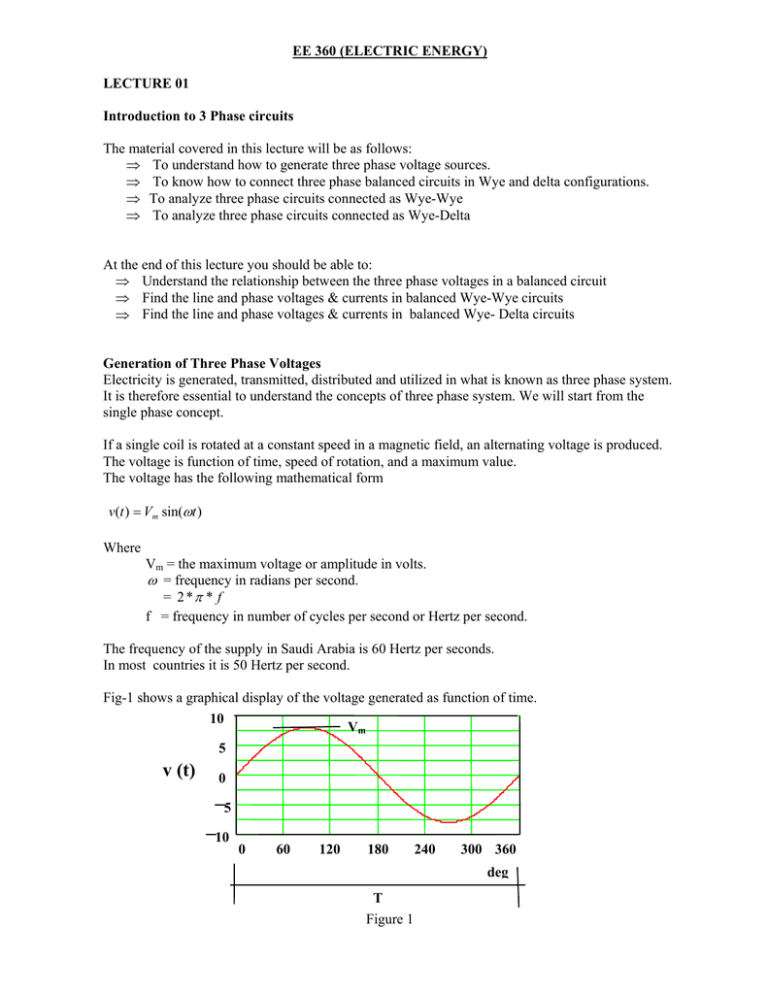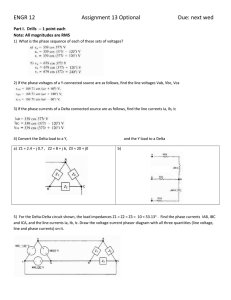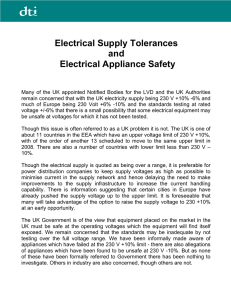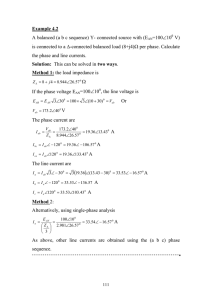Lec 1 Three phase Circuits
advertisement

EE 360 (ELECTRIC ENERGY) LECTURE 01 Introduction to 3 Phase circuits The material covered in this lecture will be as follows: ⇒ To understand how to generate three phase voltage sources. ⇒ To know how to connect three phase balanced circuits in Wye and delta configurations. ⇒ To analyze three phase circuits connected as Wye-Wye ⇒ To analyze three phase circuits connected as Wye-Delta At the end of this lecture you should be able to: ⇒ Understand the relationship between the three phase voltages in a balanced circuit ⇒ Find the line and phase voltages & currents in balanced Wye-Wye circuits ⇒ Find the line and phase voltages & currents in balanced Wye- Delta circuits Generation of Three Phase Voltages Electricity is generated, transmitted, distributed and utilized in what is known as three phase system. It is therefore essential to understand the concepts of three phase system. We will start from the single phase concept. If a single coil is rotated at a constant speed in a magnetic field, an alternating voltage is produced. The voltage is function of time, speed of rotation, and a maximum value. The voltage has the following mathematical form v(t ) = Vm sin(ωt ) Where Vm = the maximum voltage or amplitude in volts. ω = frequency in radians per second. = 2 *π * f f = frequency in number of cycles per second or Hertz per second. The frequency of the supply in Saudi Arabia is 60 Hertz per seconds. In most countries it is 50 Hertz per second. Fig-1 shows a graphical display of the voltage generated as function of time. 10 Vm 5 v (t) 0 5 10 0 60 120 180 240 300 360 deg T Figure 1 If three coils (a, b &c) , each occupying 120 degrees in space, are rotated at the same speed within the same magnetic , they will produce identical voltages except that they are shifted from each other by 120 degrees. Mathematically these are represented as follows: v a (t ) = Vm sin(ωt ) (1) vb (t ) = Vm sin(ωt − 120) (2) vc (t ) = Vm sin(ωt − 240) (3) These are referred to as balanced three phase voltages. Fig-2 shows a graphical display of the voltage generated as function of time. Figure 2 For the purpose of circuit analysis, frequency domain and phasor representation are used. Each sinusoidal signal is represented by its equivalent rms and its angular shift from a reference signal. The rms of the sinusoidal signal is given as follow V = Vm / 2 (4) Using phase a as a reference, the three phase system can be described as follows: V a= V∠0 0 Vb = V∠ − 120 0 Vc = V∠ − 240 0 Fig-3 shows a the phasor representation of 3 phase voltages referred to phase a. Figure 3 Wye and Delta Connections Each coils has two ends: a start and an end. For a 3 phase system this means there is a need for six conductors In order to reduce the conductor loses, it is essential to reduce the number conductors . This is achieved by connecting the coils, or phases , in either of two forms. These are called Wye and Delta connections. However, before we describe the Wye and delta connections, it is important to make the following definitions Phase describes one element or device in a load, line, or source. It is simply a "branch" of the circuit.. Line refers to the "transmission line" or wires that connect the source (supply) to the load. Neutral the 4th wire in the 3-phase system. It's where the phases of a Wye connection come together. Phase Voltages & Phase Currents The voltages and currents across and through a single branch (phase) of the circuit. Line Currents The currents flowing in each of the lines (Ia, Ib, and Ic). Line Voltages The voltages between any two of the lines (Vab, Vbc, and Vca). These may also be referred to as the line-to-line voltages. Line to Neutral Voltages The voltages between any lines and the neutral point (Va, Vb, and Vc). . a. Wye (Y or Star) Connection The ends of the three phases are connected together to form the neutral while the other ends ( or terminals form the line connections. Figure 4 shows the Wye or star connection of a 3 phase system Ia a Van Vab n Vbn Ib Vca b Vcn Vbc Ic c Let us determine the relationships between the line and phase voltages. Vab = Va − Vb (8) Vab = V∠0 − V∠ − 120 Vab = V (1 − 1∠ − 120) = V (1 − cos(120) − j sin(120)) = V (1 − (−1 / 2) + j ( 3 / 2)) = V (3 / 2 + j ( 3 / 2)) Converting to polar form and re-arranging the terms. Vab = Va * 3∠30 0 (9) This result is states as follows The line to line voltage is related is related to the phase voltage by a factor of angle of 30 degrees. Also the currents in lines are the same as those flowing through the phase. This is stated as line current is always equal to the phase current. Il = I p (10) Example 1 Let us assume that the phase voltage is 120-V. Find the line voltage? V a= 120∠0 0 Vb = 120∠ − 120 0 3 and it leads it by an Vab = 120∠0 − 120∠ − 120 Vab = 120(1 − 1∠ − 120) Vab = 120 * 3∠30 0 Vab = 207.85∠30 0 Vbc = 207.85∠ − 90 0 Vca = 207.85∠ − 210 0 We say that the voltage between the lines is 208 volts (rounding up), and thus the power system voltage is designated as 120/208-V. Loads in a facility such as a building, a factory and others may also be arranged in 3 phase configurations. They can be connected in a Wye or star configurations. Fig 5 shows a Wye connected source supplying a Wye-connected load. This system is referred to a 3-wire System. The neutral points are not connected together. This system is not widely used. Van Vbn Za Vcn Zb Zc Figure 5 Fig 6 shows a Wye connected source supplying a Wye-connected load with the two neutrals connected. This system is referred to a 4-wire. Van Za Vbn Vcn Zc Figure 6. In a 4-wire system, the following relationship can be written: Zb Ia = Van Za Ib = Vbn Zb Ic = Vcn Zc (11) Having a balanced circuit allows for simplified analysis of the 3-phase circuit. Following are the requirements that must be satisfied in order for a 3-phase system or circuit to be balanced. 1. All 3 sources are represented by a set of balanced 3-phase variables 2. All loads are 3-phase with equal impedances 3. Line impedances are equal in all 3 phases If the circuit is balanced, we can solve for the voltages, currents, and powers, etc. in one phase using circuit analysis. This is called equivalent single phase. If the circuit is not balanced, all three phases should be analyzed in details. This is not addressed in this chapter. Example 2 A 4-wire Y-connected 3-phase 120/208-V source is connected to Y-connected balanced load. The impedance per phase is 12∠30 0 Ω . Find (i) the phase and line voltages at the load (ii) the phase and line currents through the load. Solution Using Phase a as a reference (i)The phase voltage ate the load are given as follows: V an= 120∠0 0 Vbn = 120∠ − 120 0 Vcn = 120∠ − 240 0 The line-line voltages at the load are given by: Vab = 207.85∠30 0 Vbc = 207.85∠ − 90 0 Vca = 207.85∠ − 210 0 (ii) In Y-connected load , the phase and line currents are equal. Ia = Van Za I a = 120∠0 0 / 12∠30 0 I a = 10∠ − 30 0 A. Similarly the phase currents of phases b & c are given as follows: I b = 10∠ − 150 0 A I c . = 10∠ − 270 0 A b. Delta ( or ∆ ) Connection The end of one phase is connected to the start of another phase to form a closed loop referred to as delta connection. Figure 7 shows a typical ∆ connection of sources. Figure 7 As shown in Figure 7, The line voltage Vab is equal to phase voltage Va. However, for the purposes of analysis, Delta connected source are converted into equivalent Yconnected sources. The analysis then follows the same procedure outlined earlier. The equivalent phase voltage is related to the line voltage by equation (12) Van = Vab − j 30° e 3 The delta connected source is not widely used. Delta connected Loads Three phase loads are connected in ∆ configuration as shown in figure 8. a Ia a Vab Za b Iab Z ca Vca b Ica Vbc b Ib c Ibc c Zbc Ic For a balanced load, the line and phase voltages are equal. The relationship of the phase and line currents is derived as follows: Using KCL, the current in line I a a is related to the phase currents I ab and I ca I a = I ab − I ca For a balanced load, the phase currents are equal but shifted by angle of 120 degrees. Using the same procedure for determining the line voltage in the case of the Y connection, I a = 3 * I ab ∠ − 30 0 A The line current is related to the phase current by a factor of degrees. 3 and it lags it by an angle of 30 Example 3 A 3-wire Y-connected 3-phase 120/208-V source is connected to ∆ -connected balanced load. The impedance per phase is 12∠30 0 Ω . Find (i) the phase and line voltages at the load (ii) the phase and line currents through the load. Solution For a ∆ connected load, the phase and line voltages are equal. The voltage between the two lines( or phases) is 208 ∠0 0 V. (i) Vab=VL= 208-V. (ii) The phase current Iab= Vab Z ab The phase current 208∠0 = 17.33∠ − 30 A 12∠30 0 I a = 3 * I ab ∠ − 30 0 A Iab= The line current I a = 3 * 17.33∠ − 60 0 A I a = 30.0∠ − 60 0 A Summary • In balanced "Y" circuits, line voltage is equal to phase voltage times the square root of 3, while line current is equal to phase current. Vab = Va * 3∠30 0 Il = I p • In balanced ∆ circuits, line voltage is equal to phase voltage, while line current is equal to phase current times the square root of 3. I a = 3 * I ab ∠ − 30 0 A Vab = Va





